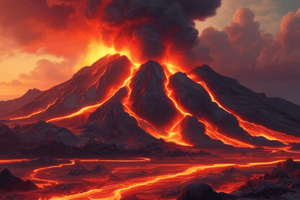Podcast
Questions and Answers
What is the main factor that determines the behavior of lava?
What is the main factor that determines the behavior of lava?
- Temperature
- Chemical composition (correct)
- Distance from the volcanic vent
- Viscosity
Which type of lava has low amounts of silica and high amounts of magnesium and iron?
Which type of lava has low amounts of silica and high amounts of magnesium and iron?
- Intermediate lava
- Pillow lava
- Mafic lava (correct)
- Felsic lava
What is the main reason for the difference in viscosity between mafic and felsic lava?
What is the main reason for the difference in viscosity between mafic and felsic lava?
- Temperature
- Distance traveled from the volcanic vent
- Chemical composition
- Silica content (correct)
Which minerals are commonly formed by felsic lava?
Which minerals are commonly formed by felsic lava?
What type of lava flow is characterized by a smooth and shiny surface, often with ropey textures?
What type of lava flow is characterized by a smooth and shiny surface, often with ropey textures?
What is the temperature of lava?
What is the temperature of lava?
What is the major cause of the explosive nature of lava?
What is the major cause of the explosive nature of lava?
What is the major component of lava?
What is the major component of lava?
What does the term 'magma' refer to when inside the Earth's crust?
What does the term 'magma' refer to when inside the Earth's crust?
What factor determines the distance that lava flows?
What factor determines the distance that lava flows?
What type of lava flow is associated with mafic lava?
What type of lava flow is associated with mafic lava?
Which type of lava flow forms smooth blocks of around one meter?
Which type of lava flow forms smooth blocks of around one meter?
Under what conditions are pillow lavas typically formed?
Under what conditions are pillow lavas typically formed?
What are the characteristics of pahoehoe lava flows?
What are the characteristics of pahoehoe lava flows?
What distinguishes blocky lava flows from other types of lava flows?
What distinguishes blocky lava flows from other types of lava flows?
Flashcards are hidden until you start studying
Study Notes
Lava Behavior
- Silica content is the primary factor determining lava behavior.
- Mafic lava has low silica, high magnesium, and iron.
Lava Viscosity
- Silica content determines viscosity: Higher silica = higher viscosity.
- Mafic lava is less viscous than felsic lava, due to lower silica content.
Felsic Lava Minerals
- Felsic lava commonly forms minerals like quartz, feldspar, and mica.
Pahoehoe Lava Flows
- Pahoehoe flows have a smooth, shiny surface with ropey textures.
Lava Temperature
- Lava temperature varies, but typically ranges from 700°C to 1,200°C (1,292°F to 2,192°F).
Explosive Lava
- Dissolved gases are the primary cause of explosive lava eruptions.
Lava Composition
- Lava is primarily composed of molten rock (magma).
Magma
- Magma is molten rock found beneath the Earth's crust.
Lava Flow Distance
- Viscosity and volume of lava determine flow distance: Higher viscosity = shorter flow.
Mafic Lava Flows
- Mafic lavas typically flow as pahoehoe or aa flows.
Blocky Lava Flows
- Blocky flows, characterized by rough, jagged, and blocky shapes, are associated with felsic lavas.
Pillow Lavas
- Pillow lavas, formed by underwater eruptions, are smooth, rounded, and pillow-shaped.
Pahoehoe Lava Characteristics
- Pahoehoe flows are characterized by smooth, ropey surfaces, and often flow as thin sheets or tubes.
Blocky Lava Flow Distinctions
- Blocky lava flows are distinguished by their irregular, angular blocks and lack of ropey textures.
Studying That Suits You
Use AI to generate personalized quizzes and flashcards to suit your learning preferences.




